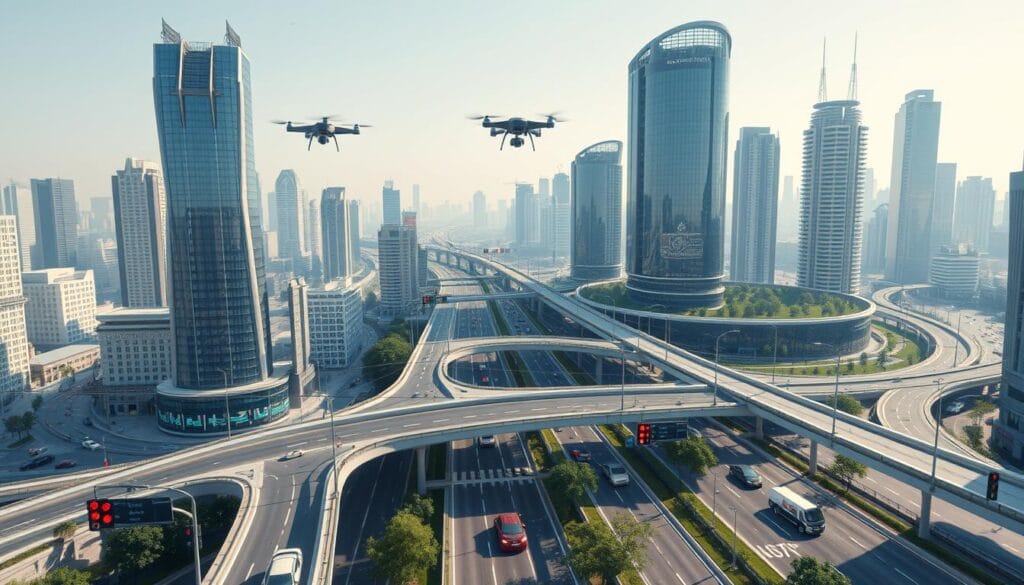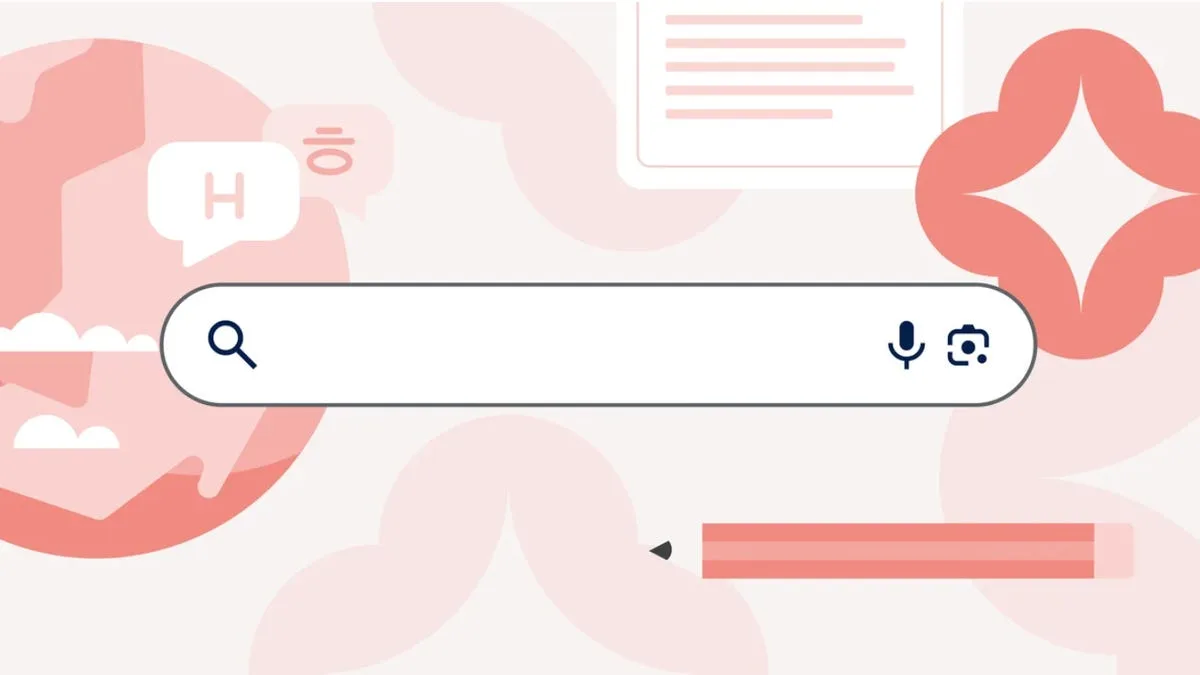Every US citizen loses about 97 hours each year stuck in traffic. This costs them around USD 1,348 in wasted fuel. As cities grow, managing traffic becomes crucial for smooth movement of vehicles and pedestrians. AI in traffic offers a solution using advanced algorithms and data analytics.
Smart traffic systems help reduce gridlock and pollution. They improve urban life quality. They also create an efficient transportation network, leading to economic gains1.
AI in traffic offers logistical benefits and supports sustainable mobility. It tackles issues like traffic bottlenecks and emergency vehicle access. It shows promise in streamlining operations and boosting road safety12.
Key Takeaways
- AI significantly improves traffic management efficiency.
- Smart traffic systems can reduce congestion and travel times.
- Urban traffic optimization is essential for sustainable city development.
- AI solutions for traffic enhance safety and emergency response.
- Integrating advanced analytics can lead to economic benefits.
The Importance of Traffic Management

Traffic management is key for smooth transportation in cities. As cities expand, managing traffic gets harder. We need smart traffic systems to solve these problems.
These systems help move cars and people in busy cities. They are crucial for keeping traffic flowing well.
Understanding Traffic Management Systems
Today’s traffic systems use new tech to make roads safer and smoother. They use data to watch traffic in real-time. This helps find ways to reduce traffic jams.
AI is a big help in managing traffic. It watches traffic and changes signals to keep things moving. This makes driving in cities better3.
Cities are also using smart signals that adjust to traffic. This makes busy roads less crowded4.
Challenges of Urban Traffic Management
Managing traffic in cities is tough because of more cars and unexpected events. We need to handle sudden changes and accidents well. AI helps spot these issues early and gives data for quick fixes.
For example, Phoenix cut vehicle delay by 40% with AI traffic systems5. Using smart traffic systems can also make roads safer and cut down on pollution3.
How AI Can Transform Traffic Management
Artificial Intelligence is changing traffic management. It uses real-time data to make roads safer and more efficient. AI systems combine different data sources to show the full picture of road conditions.
This helps cities plan better for traffic. They can predict jams and fix problems early. This leads to less traffic and fewer delays.
Real-time Traffic Monitoring and Analysis
AI makes traffic management better by using real-time data. In Los Angeles, AI at traffic lights cut travel times by 12%6. Pittsburgh’s Surtrac system has seen a 25% drop in travel times and 40% less idle time at lights6.
These examples show AI’s power in traffic analysis. It helps cities plan better routes and improve traffic flow.
Incident Detection and Management
AI is key in spotting incidents quickly. It analyzes data in real-time to find accidents or blockages fast. This means quicker alerts to traffic centers and police.
AI makes roads safer and emergency services more efficient. For example, AI helps cities adjust traffic plans based on current conditions7. AI’s growth promises a future where smart cities manage traffic better.
AI Applications in Traffic Signal Control
AI is changing traffic signal control systems for the better. It makes them work more efficiently and effectively. Now, traffic lights can adjust to real-time conditions thanks to adaptive signal control.
Old systems used fixed schedules, but they can’t handle changing traffic well. AI uses advanced algorithms to make smarter decisions. This leads to smoother traffic and less congestion.
Adaptive Traffic Signal Control
Adaptive traffic signal control uses AI to adjust light timings based on traffic. It’s especially helpful in busy cities where traffic jams are common. For example, in 2022, Chicago drivers lost 155 hours to traffic.
AI helps by making traffic flow better. It reduces wait times at intersections. This makes driving faster and safer by cutting down on accidents.
Benefits of Intelligent Traffic Lights
Smart traffic lights do more than just improve traffic flow. They also help the environment by reducing fuel use and emissions. In the U.S., transportation is a big source of greenhouse gas emissions, making these changes important for the planet.
AI can cut emissions at intersections by almost 10% and reduce stops by up to 30%. Cities with these systems see better public transit and mobility. This makes cities more livable and efficient.
How to Use AI in Traffic?
Using AI in traffic management starts with good data. It means combining data from many sources like traffic sensors and GPS. This helps improve traffic flow and makes traffic management smarter.
In places like Denmark, AI is being used more. They’re using smart sensors to get important traffic data8.
Data Integration for Enhanced Traffic Flow
Combining data from different sources is key. AI helps make traffic systems better by adjusting in real-time. It also uses predictive analytics to prevent traffic jams.
For example, AI can cut waiting times by 5-10% by predicting traffic better8. With over 1.47 billion vehicles worldwide9, cities are turning to AI to manage traffic better and keep roads safe.
Leveraging Predictive Analytics
Predictive analytics is crucial for managing traffic. AI uses advanced algorithms to forecast traffic patterns. This helps authorities make early changes to traffic signals.
This approach can greatly improve traffic by spotting problems before they start. AI can also reduce delays by optimizing traffic signals8. Plus, it helps find the best routes, making travel faster and smoother.
Environmental Benefits of AI in Traffic Management
Using AI in traffic management brings big wins for the environment. It makes traffic flow better and cuts down on emissions and fuel use. Cities can make the air cleaner and reduce harmful gases from cars by using AI.
In places like Los Angeles and Pittsburgh, AI has made travel times shorter. This means less fuel is used, making the city cleaner10.
Reducing Emissions and Fuel Consumption
Transportation is a big source of greenhouse gas emissions in the U.S., making up about 29%11. AI can help by cutting down on traffic stops and reducing emissions at lights by nearly 10%11. It also helps keep traffic moving smoothly, lowering emissions from idling and jams10.
Promoting Sustainable Urban Mobility
Cities are moving toward greener ways of getting around with AI. In Barcelona, AI helps more people use public transport, reducing car use12. This trend supports global goals for a cleaner planet, offering a blueprint for other cities11.
FAQ
What is AI in traffic management?
How does traffic management impact urban areas?
What challenges does urban traffic management face?
How can AI transform traffic management?
What methods does AI use for incident detection in traffic management?
What is adaptive traffic signal control?
What are the benefits of intelligent traffic lights?
How does data integration enhance traffic flow?
What role does predictive analytics play in traffic management?
What environmental benefits are associated with AI in traffic management?
How can AI promote sustainable urban mobility?
Source Links
- A Comprehensive Guide on AI in Traffic Management – Matellio Inc
- The Role of AI in Adaptive Traffic Signal Control
- AI in Traffic Management | Isarsoft
- AI in Traffic Management: 5 Effective Ways
- AI in Traffic Management: Artificial Intelligence solves traffic control issues
- Smart Cities: How AI is Revolutionizing Urban Traffic Management
- AI in Transportation: How AI Technology is Revolutionizing Traffic Management
- AI-based Traffic Management
- AI in Traffic Management: From Congestion to Coordination by Mostafa Ibrahim
- Top AI Startups Revolutionizing Traffic Management | Traction Five | Traction Technology
- Green Means Go: Seattle’s AI Solution to Reduce Stoplight Idling
- AI in Transportation: Benefits, Use Cases, and Examples







